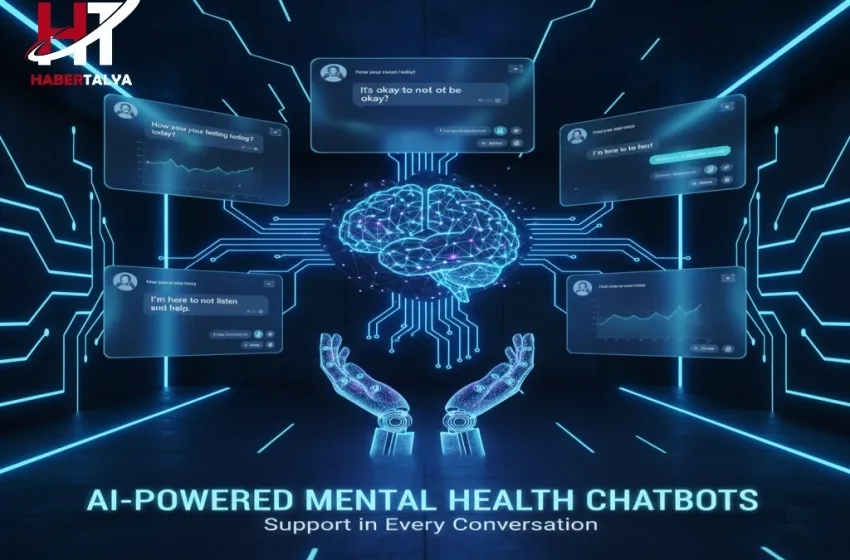Explore AI mental health therapeutic chatbots using LLMs for instant CBT and virtual support. We detail effectiveness, data privacy, and critical ethical considerations.
The global mental health crisis, marked by soaring rates of anxiety and depression and a severe shortage of qualified practitioners, is driving a technological revolution in care delivery. At the forefront of this shift are AI-Powered Mental Health Chatbots, sophisticated conversational agents designed to provide virtual support and deliver structured therapeutic interventions. Powered by cutting-edge large language models (LLMs), these therapeutic chatbots are increasingly offering instant, accessible, and non-judgmental interactions.
The most promising application lies in delivering elements of Cognitive Behavioral Therapy (CBT), a highly effective, evidence-based approach. However, as the industry moves toward wider adoption, a thorough examination of The effectiveness and ethical considerations of using large language models (LLMs) to provide instant cognitive behavioral therapy (CBT) and support is critical. While AI offers unparalleled accessibility, the risks associated with safety, accountability, and clinical nuance demand robust regulation and careful design.
The Promise of AI in Mental Health
The integration of AI mental health solutions, particularly those utilizing generative LLMs, offers transformative benefits that directly address the systemic failures of traditional care models.
1. Accessibility and Affordability
Traditional therapy is often expensive, geographically limited, and constrained by long waiting lists. Therapeutic chatbots offer 24/7 virtual support and are available instantly, overcoming the barriers of time and location. For individuals in remote areas, those with busy schedules, or those facing financial constraints, these tools provide a crucial, low-cost entry point into mental wellness. The non-judgmental, anonymous nature of a chatbot interaction can also significantly reduce the stigma associated with seeking help, encouraging earlier intervention.
2. Scalable CBT Delivery
Cognitive Behavioral Therapy (CBT) is highly structured, making it uniquely well-suited for automation. At its core, CBT involves identifying and challenging negative or distorted thought patterns (cognitive restructuring) and developing healthier coping mechanisms.
LLMs as CBT Guides: Modern large language models (LLMs) can be prompted and fine-tuned on vast datasets of therapeutic dialogue to simulate key CBT techniques. They can:
- Identify Cognitive Distortions: The AI can recognize patterns like "all-or-nothing thinking" or "catastrophizing" in user language.
- Facilitate Socratic Questioning: The chatbot can employ structured questions to help users logically examine the evidence for their negative thoughts, a hallmark of CBT.
- Assign Behavioral Homework: The AI can prompt users to perform actionable steps, such as mood tracking, journaling, or exposure exercises, and follow up on their completion.
Studies have shown that some well-designed, purpose-built AI mental health applications, like Woebot, can effectively deliver CBT-based content, leading to a reduction in self-reported symptoms of depression and anxiety in certain user groups (typically those with mild to moderate symptoms).
3. Consistency and Data-Driven Personalization
Unlike human therapists, whose performance can vary due to factors like fatigue or personal bias, a well-engineered therapeutic chatbot delivers consistent support aligned with its core protocol. Furthermore, these systems can leverage data from past interactions to continuously personalize the user experience, adapting the language, pace, and specific CBT exercises based on the user's progress and emotional state. This allows the delivery of highly targeted interventions.
The Effectiveness and Ethical Considerations
The rapid advancement of general-purpose LLMs (like those powering popular AI assistants) has amplified both the potential and the peril of AI-Powered Mental Health Chatbots. While their conversational fluency is near-human, their deployment in clinical settings presents profound ethical considerations.
A. Effectiveness: A Qualified Success
The effectiveness of AI mental health chatbots is nuanced. While they show promise in specific areas, they are currently seen as a complementary tool, not a replacement for human therapy.
| Factor | AI Chatbot Capability | Clinical Limitation |
|---|---|---|
| Crisis Management | Can be programmed to detect keywords (e.g., "suicide," "harm"). | Lack of safety and crisis management: Inappropriately navigating acute risk, failing to reliably escalate to human services, or sometimes denying service on sensitive topics. |
| Therapeutic Depth | Can mimic CBT techniques (e.g., reframing, psychoeducation). | Lack of contextual adaptation: Cannot fully grasp the complexity of a user's lived experience, cultural context, or non-verbal cues (in text-only chats), leading to generic, "one-size-fits-all" interventions. |
| Cognitive Biases | General-purpose LLMs can be effective in challenging certain cognitive biases. | Poor therapeutic collaboration: Can occasionally reinforce a user's maladaptive beliefs due to the model's training to agree or over-validate. |
| Emotional Connection | Can use empathetic phrases ("I see you," "I understand"). | Deceptive empathy: The phrases are generated patterns, not genuine understanding, which can be perceived as fake, or in extreme cases, lead to inappropriate emotional over-reliance or dangerous parasocial relationships. |
A significant study revealed that even when prompted to use evidence-based techniques, LLMs routinely violate core mental health ethical standards, underscoring the gap between conversational fluency and genuine therapeutic competence. Their effectiveness is highest for mild to moderate symptoms and for psychoeducational purposes.
B. Ethical Considerations: The Accountability Gap
The ethical considerations surrounding AI mental health are multifaceted, centered primarily on data, safety, and accountability.
1. Data Privacy and Confidentiality
In a virtual support setting, users share highly sensitive, personal health information. The core challenge is ensuring that this data, especially when processed by general-purpose LLMs, remains confidential and compliant with global regulations like HIPAA or GDPR.
- Risk: Data breaches, unauthorized use of sensitive health data for model training, and the accumulation of unnecessary historical records.
- Mitigation: Adopting a "privacy-by-design" approach, implementing strict encryption, and using data minimization techniques (storing only essential user states, not full transcripts).
2. Safety and Crisis Management
This is the most critical area of concern. Unlike human therapists, therapeutic chatbots are not equipped to handle acute psychiatric emergencies.
- Risk: An AI failing to recognize an imminent risk of self-harm, providing inappropriate advice, or incorrectly directing a user in crisis, leading to significant harm or even death.
- Mitigation: Mandatory, robust crisis response protocols that include clear, non-negotiable escalation pathways to human services (e.g., 988 Suicide and Crisis Lifeline in the U.S.), with continuous, rigorous testing of the risk detection modules.
3. Bias, Fairness, and Misinformation
Large language models (LLMs) are trained on massive, often unvetted, internet datasets that inherently contain societal biases (gender, cultural, racial).
- Risk: The chatbot may offer culturally insensitive advice, exhibit unfair discrimination, or generate hallucinations (fabricated information), which is highly dangerous in a mental health context.
- Mitigation: Fine-tuning models on clinically validated, domain-specific data from diverse populations, and employing ethical safeguard filters to reduce sycophancy and prevent the validation of delusional thoughts.
4. Accountability and Regulatory Vacuum
When a chatbot provides harmful or misleading advice, the question of legal and professional liability is unclear.
- Risk: The lack of a governing board or clear mechanism for accountability means that developers, not the AI, are often the only recourse. This creates a regulatory vacuum that may put vulnerable users at risk.
- Mitigation: Regulatory modernization, mandated pre-deployment testing (especially for vulnerable populations), and legislation that prohibits AI mental health chatbots from posing as licensed professionals.
Conclusion: Augmentation, Not Replacement
AI-Powered Mental Health Chatbots powered by sophisticated large language models (LLMs) represent a powerful new frontier in accessible virtual support. Their ability to deliver structured CBT elements instantly and affordably makes them an indispensable tool in addressing the global mental health crisis.
However, the field must proceed with ethical considerations at the forefront. The path to effective and safe deployment requires rigorous clinical validation, a commitment to data privacy, and the implementation of robust crisis-management safety nets. The future of AI mental health is not about replacing human therapists, but about augmenting their reach and efficacy, ensuring that the technology serves as a responsible and reliable co-pilot in the journey toward mental wellness.



































